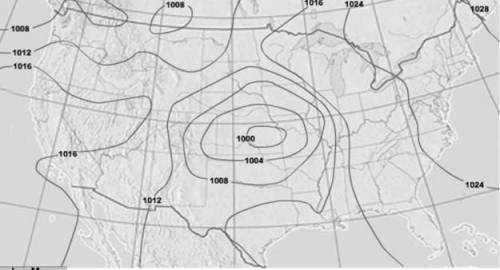
Biology, 05.02.2021 01:20 katelynn73
50 POINTS PLUS BRAIN-lIST IF YOU DO ALL THE QUESTIONS
1. (2 points) On the map, label two high-pressure areas with the letter H.
2. (2 points) On the map, label two low-pressure areas with the letter L.
3. (3 points) Explain, using complete sentences, over which area(s) would you expect to see rain or snow?
4. (3 points) Explain, using complete sentences, over which area(s) would you expect to see clear skies?
READ THIS:
In the northern hemisphere, the wind blows clockwise around centers of high pressure. The wind blows counterclockwise around lows. It is the opposite in the southern hemisphere.
5. (2 points) Draw arrows around one of the Highs (H) on the map to show the wind direction. (snip the map again to draw arrows on it)
6. (2 points) Draw arrows around one of the Lows (L) on the map to show the wind direction. (snip the map again to draw arrows on it)
7. (3 points) Imagine that you live in Maine. Currently there is a high-pressure area over Maine. If a low-pressure area moves in, how will the direction of the wind change? Explain in complete sentences.
8. (3 points) Imagine that you live in Colorado. Currently there is a low-pressure area over Colorado. If a high-pressure area moves in, how will the direction of the wind change? Explain in complete sentences.


Answers: 1


Another question on Biology

Biology, 21.06.2019 15:30
Order the steps of protein synthesis. amino acids are lined up in a sequence. rna is modified into mrna. dna is transcribed. a ribosome binds to mrna. chemical bonds are formed and a protein is produced.
Answers: 3

Biology, 22.06.2019 06:10
Long-period comets come from the oort cloud particles in earth’s atmosphere material from the asteroid belt the kuiper belt
Answers: 2

Biology, 22.06.2019 09:00
The bacteria inside a tube worm would be analogous to what organism in the ocean ecosystem near the waters surface? a. photosynthetic algae b. shrimp c. clown fish d. parasitic lamprey
Answers: 1

Biology, 22.06.2019 20:30
Our planet has experienced five major extinctions in the four billion year history of life. the first, 450 million years ago, occurred shortly after the evolution of the first land-based plants and 100 million years after the cambrian explosion. the second extinction occurred 350 million years ago, causing the formation of coal forests. next earth experienced two mass extinctions during the triassic period, between 250 and 200 million years ago. the fifth mass extinction occurred 65 million years ago, ending the reptilian dominance of the earth. according to richard leakey, the sixth mass extinction is happening right now. leakey suggests that we, the human race, are the cause. each year, at our hand, approximately 50,000 species vanish from earth. he believes that man is destroying earth at a rate comparable with the impact of a giant asteroid. leakey's statistics indicate that 50% of earth's species will become extinct within the next 100 years assuming leakey's hypothesis of a sixth mass extinction to be true, how will we expect the model to change? a) a sharp spike in the graph approximately 100 million years from now b) a dip in the graph, followed by a sharp spike about 100 million years from now c) a sharp spike in the graph immediately following the "0" location of the x axis d) a plateau following the "0" mark on the x axis, followed by a gradual rise to a new peak
Answers: 3
You know the right answer?
50 POINTS PLUS BRAIN-lIST IF YOU DO ALL THE QUESTIONS
1. (2 points) On the map, label two high-pres...
Questions










Health, 20.03.2021 01:00


Mathematics, 20.03.2021 01:00

Mathematics, 20.03.2021 01:00


Mathematics, 20.03.2021 01:00

History, 20.03.2021 01:00

Medicine, 20.03.2021 01:00





